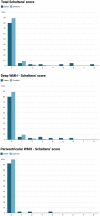Brain white matter hyperintensities in Kawasaki disease: A case-control study
- PMID: 36330348
- PMCID: PMC9623056
- DOI: 10.3389/fnins.2022.995480
Brain white matter hyperintensities in Kawasaki disease: A case-control study
Abstract
Background: Cerebrovascular involvement of Kawasaki disease (KD) is poorly studied. White matter hyperintensities (WMH) indicate cerebral small vessel disease and increase the risk for stroke.
Purpose: To investigate whether childhood KD is associated with WMHs and other cerebrovascular findings later in adulthood.
Materials and methods: In this case-control study, patients diagnosed with KD (cases) at our tertiary hospital between 1978 and 1995 were invited to brain magnetic resonance (MRI) between 2016 and 2017. Migraine patients (controls) with available brain MRI were matched with cases (ratio 4:1) by age (±2 years) and sex. Two blinded neuroradiologists evaluated independently cerebrovascular findings from the brain MRI scans. Modified Scheltens' visual rating scale was used to evaluate WMH burden and the total WMH volume was measured using manual segmentation.
Results: Mean age [years, (SD)] at the time of brain MRI was 33.3 (3.8) and 32.8 (4.0) for cases (n = 40) and controls (n = 160), respectively (P = 0.53). Mean follow-up time for cases was 29.5 years (4.3). Total volume of WMHs (median) was 0.26 cm3 (IQR 0.34) for cases and 0.065 cm3 (IQR 0.075) for controls, P = 0.039. Cases had higher total WMH burden (P = 0.003), deep WMH burden (P = 0.003), and more periventricular WMHs (prevalence 7.5 vs. 0%, P = 0.008) than controls. Cases had greater risk of having total Scheltens' score ≥2 vs. < 2 (odds ratio, 6.88; 95% CI: 1.84-25.72, P = 0.0041) and ≥3 vs. < 3 (odds ratio, 22.71; 95% CI: 2.57-200.53, P = 0.0049). Diabetes type 1/type 2, hypertension, smoking status or hypercholesterolemia were not risk factors for WMH burden, p > 0.1. Myocarditis at the acute phase of KD increased the risk for periventricular WMHs (P < 0.05). Three cases (7.5%) and three controls (1.9%) had lacune of presumed vascular origin (P = 0.0096).
Conclusion: History of KD could be associated with an increased WMH burden. More studies are needed to confirm our results.
Keywords: Kawasaki disease; brain MRI; cerebrovascular abnormalities; follow up; white matter hyperintensities.
Copyright © 2022 Laukka, Parkkola, Hirvonen, Ylikotila, Vahlberg, Salo, Kivelev, Rinne and Rahi.
Conflict of interest statement
The authors declare that the research was conducted in the absence of any commercial or financial relationships that could be construed as a potential conflict of interest.
Figures


Similar articles
-
Association of intracranial atherosclerotic stenosis with severity of white matter hyperintensities.Eur J Neurol. 2015 Jan;22(1):44-52, e2-3. doi: 10.1111/ene.12431. Epub 2014 Apr 9. Eur J Neurol. 2015. PMID: 24712717
-
The Characteristics of White Matter Hyperintensities in Patients With Migraine.Front Pain Res (Lausanne). 2022 Jun 20;3:852916. doi: 10.3389/fpain.2022.852916. eCollection 2022. Front Pain Res (Lausanne). 2022. PMID: 35794956 Free PMC article.
-
Cerebrovascular reactivity as a determinant of deep white matter hyperintensities in migraine.Neurology. 2019 Jan 22;92(4):e342-e350. doi: 10.1212/WNL.0000000000006822. Epub 2019 Jan 4. Neurology. 2019. PMID: 30610094
-
Characterization of White Matter Hyperintensities in Large-Scale MRI-Studies.Front Neurol. 2019 Mar 26;10:238. doi: 10.3389/fneur.2019.00238. eCollection 2019. Front Neurol. 2019. PMID: 30972001 Free PMC article.
-
Association Between White Matter Hyperintensities and Chronic Kidney Disease: A Systematic Review and Meta-Analysis.Front Med (Lausanne). 2022 May 3;9:770184. doi: 10.3389/fmed.2022.770184. eCollection 2022. Front Med (Lausanne). 2022. PMID: 35592851 Free PMC article.
Cited by
-
Plasma levels of glial fibrillary acidic protein and neurofilament light chain in patients with chronic migraine: a multicenter case-control study.Neurol Sci. 2025 May;46(5):2209-2216. doi: 10.1007/s10072-025-08011-2. Epub 2025 Jan 25. Neurol Sci. 2025. PMID: 39856378
-
Linking Kawasaki Disease to Mental Health: A Nationwide Study on Long-Term Neurological Risks.Medicina (Kaunas). 2025 Mar 26;61(4):604. doi: 10.3390/medicina61040604. Medicina (Kaunas). 2025. PMID: 40282895 Free PMC article.
-
Serum neurofilament light chain levels in migraine patients: a monocentric case-control study in China.J Headache Pain. 2023 Nov 6;24(1):149. doi: 10.1186/s10194-023-01674-2. J Headache Pain. 2023. PMID: 37932721 Free PMC article.
References
-
- Alber J., Alladi S., Bae H. J., Barton D. A., Beckett L. A., Bell J. M., et al. . (2019). White matter hyperintensities in vascular contributions to cognitive impairment and dementia (VCID): knowledge gaps and opportunities. Alzheimers Dement. 5, 107–117. 10.1016/j.trci.2019.02.001 - DOI - PMC - PubMed
LinkOut - more resources
Full Text Sources

